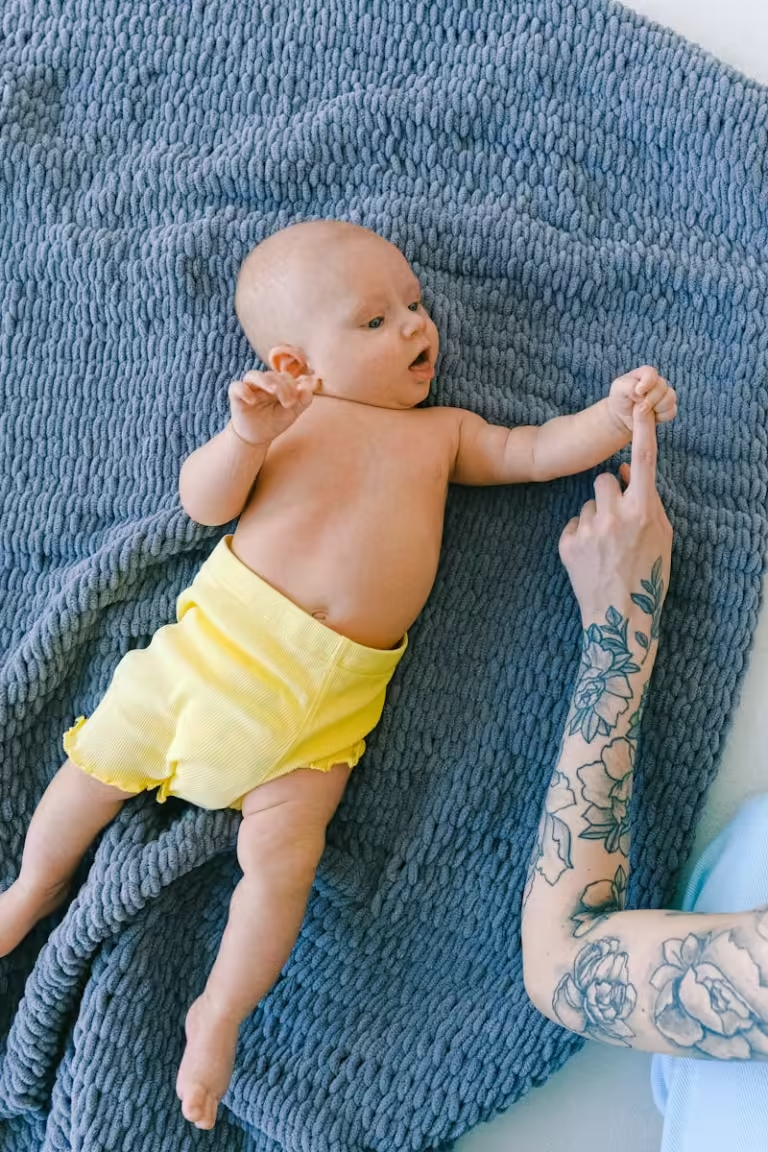
I. Introduction: From Babbling Brook to Fluent Speaker
Imagine a world without language, where communication rests solely on gestures and grunts. It might seem unimaginable, yet every tiny human embarks on this journey as they enter the world. The transformation from gurgling infant to articulate speaker is a remarkable feat, unfolding in fascinating stages. Did you know that babies can recognize the rhythm and flow of their native language while still in the womb? This early exposure sets the stage for a journey of sound exploration and meaning-making, a journey we’ll delve into in this chapter.
Language and speech are fundamental tools for navigating the world. For babies, they’re not just about exchanging information; they’re about forging connections, expressing needs, and building relationships. Every coo, babble, and first wobbly word represents a monumental step in understanding themselves and the world around them. It’s through language that babies learn to ask questions, share experiences, and develop their cognitive abilities. Imagine the frustration of wanting something you desperately need but lacking the words to convey it – that’s the initial reality for every baby. Witnessing them break through this barrier, mastering the complex intricacies of spoken language, is a privilege and a marvel.
This incredible journey unfolds in distinct stages, each marked by exciting milestones. From the first cooing sounds to the formation of their first words and beyond, each babble and giggle is a testament to the baby’s growing understanding and expressiveness. In the coming sections, we’ll explore these stages in detail, unraveling the fascinating process of how little ones transform from sound experimenters to fluent speakers, ready to engage with the world around them in a whole new way. So, buckle up and prepare to be amazed by the wonders of infant speech development!
II. From Cries to Cooing: The Early Beginnings (0-6 months)
Imagine entering a world of sensory overload, unsure of how to express your needs or understand your surroundings. That’s the reality for a newborn baby. While they lack spoken language, communication starts right from the get-go, albeit in a primitive yet essential form.
Crying is the first and most universal language of babies. Far from simply being a nuisance, each cry encodes a specific message: hunger, discomfort, fatigue, loneliness. Learning to decipher these cries is crucial for parents and caregivers, forming the bedrock of their first bond. As parents respond effectively, they’re not just soothing their baby; they’re building trust and laying the foundation for future communication.
But crying isn’t the only tool in a newborn’s communication arsenal. They soon begin venturing into the realm of basic sounds, like moans, sighs, and grunts. These may seem random at first, but they reflect developing vocal control and experimentation with expressing themselves. You might even hear “neh” sounds as they practice sucking, a reflex developed in the womb.
Around 2-3 months, a magical transformation occurs: cooing and gurgling enter the scene. These delightful sounds, often triggered by happy interactions or tummy time, mark a significant leap. Babies are gaining control over their vocal cords, experimenting with pitch and rhythm. Cooing might resemble “ooh” and “aah” sounds, while gurgling adds a playful, bubbly element. These vocalizations aren’t just cute; they represent crucial practice for future speech production and a joyful exploration of their own vocal potential.
But communication isn’t a one-way street. Early exposure to language plays a critical role in this stage. Talking to, singing to, and reading to your baby exposes them to the rhythm, flow, and sounds of language, priming their brains for speech development. It also fosters interaction, creating a back-and-forth exchange that reinforces the power of communication and encourages further vocal exploration.
Every coo, gurgle, and babble in these early months is a building block, paving the way for future speech development. By responding attentively, providing rich language exposure, and engaging in playful interactions, parents and caregivers play a vital role in nurturing this remarkable journey.
III. Babbling Boom: Experimenting with Sounds (6-12 months)
Hold your breath, because things are about to get exciting! Buckle up for the “babbling boom,” a symphony of sounds that marks a major leap in your baby’s communication journey. Between 6 and 12 months, those delightful coos and gurgles graduate into full-blown babbling, a captivating display of vocal exploration and experimentation.
But what exactly is babbling? Imagine a mini linguist trying out every possible combination of syllables. You might hear strings of consonant-vowel sounds like “baba,” “dada,” or “mamama,” interspersed with vowel sequences like “eeoo” or “oooo.” This early experimentation falls into two main categories:
1. Canonical babbling: This is the “da-da-da” kind, characterized by repeating consonant-vowel combinations. It helps babies practice producing different speech sounds and controlling the rhythm of their vocal cords.
2. Reduplicated babbling: Think “mamamama” or “bababa.” Here, babies repeat entire syllables, further refining their control over articulation and intonation.
More than just sounding cute, babbling serves a crucial purpose. It’s a playground for practicing and perfecting the building blocks of spoken language. Each babble is a mini experiment, testing out the potential of sounds, mastering the intricacies of pronunciation, and exploring the nuances of intonation.
But caregivers aren’t just passive observers in this exciting process. Their role is crucial in shaping and encouraging babbling. Here’s how you can support your little linguist:
- Respond and imitate: When your baby babbles, respond with enthusiasm! Mirror their sounds, adding inflection and intonation. This shows them they’re being heard and encourages further babbling.
- Engage in conversations: Turn babbling into mini-dialogues. Respond to their sounds with questions, comments, and your own playful babbling. This creates a back-and-forth flow, fostering communication and turn-taking skills.
- Read and sing: Expose your baby to rich language through reading and singing. The rhythm, rhymes, and sounds in these activities stimulate their developing brain and provide models for future speech production.
Remember, babbling isn’t about achieving perfect pronunciations; it’s about experimentation and exploration. By providing a stimulating environment and engaging in responsive interactions, you become your baby’s language coach, nurturing their communication skills and setting them on the path to fluent speech. So, listen closely to the babbling symphony; it’s a beautiful soundtrack to their incredible learning journey!
IV. First Words and Beyond: Language Takes Shape (12-24 months)
The magic moment arrives! Between 12 and 24 months, the babbling starts to transform, taking on recognizable shapes and meanings. It’s a joyous time as your little one utters their first words, marking a significant leap in their communication journey. While the typical timeline suggests “mama” or “dada” around 12 months, with two-word phrases emerging by 18 months, remember, every child learns at their own pace. Celebrate each milestone, big or small, as it represents a unique triumph in their language development.
But how do these first words take shape? It’s all about making connections. Babies observe the world around them, associating objects and actions with the sounds they hear. Pointing to a ball and saying “ball,” or reaching for a cup and uttering “drink,” showcases this crucial link forming between the world and its verbal representation. Repetition plays a key role, too. Hearing words associated with specific contexts helps solidify these connections, paving the way for further vocabulary growth.
As vocabulary expands, two-word phrases emerge, marking another exciting milestone. Around 18 months, you might hear “more milk,” “go bye-bye,” or “open book,” simple combinations that express their needs and desires. These early phrases reflect their burgeoning understanding of language structure and their eagerness to communicate more complex ideas.
Soon, sentences start to unfold. Initially, these might be simple constructions like “me want cookie” or “cat sleep chair,” but they represent a crucial shift. Babies are now experimenting with grammar, stringing words together to create meaning and express themselves in increasingly sophisticated ways.
Remember, though, this journey isn’t linear. While some children progress rapidly, others take their time. Individual variations in pace, temperament, and learning styles are perfectly normal. Embrace your child’s unique learning journey, and avoid comparing them to others. Focus on creating a language-rich environment, filled with conversations, songs, and stories, and trust that their inner linguist is blossoming at their own perfect pace.
So, listen attentively to your little one’s first words, celebrate their two-word masterpieces, and marvel at the unfolding sentences, for each utterance is a testament to their remarkable language development. The world of communication is opening up to them, and you have the privilege of witnessing this incredible transformation firsthand.
V. Nurturing Communication: What You Can Do
As your little one embarks on their incredible language journey, you play a crucial role as their communication coach. While their innate drive to learn is powerful, your active involvement creates a supportive environment that fuels their progress. Here are some practical tips to nurture effective communication:
1. Talk, talk, talk: Fill your baby’s world with language. Narrate your day, sing songs, read aloud, and engage in silly conversations. Even seemingly mundane routines like changing diapers or preparing meals can be transformed into language-learning opportunities. Describe what you’re doing, ask questions, and respond to their babbles and first words with enthusiasm.
2. Make every interaction a learning experience: Point out objects, name them clearly, and encourage your baby to imitate. Play peek-a-boo, sing action songs, and engage in games that involve simple instructions. These playful interactions make learning fun and help them link words to actions and objects.
3. Embrace the power of reading: Reading to your baby from a young age exposes them to rich vocabulary, different sentence structures, and the joy of stories. Start with simple board books full of colorful pictures and gradually progress to longer storybooks with engaging narratives. Make reading time a cozy bonding experience, allowing your baby to explore the books and ask questions.
4. Let music play: Sing songs, play nursery rhymes, and expose your baby to different musical styles. Music not only soothes and entertains but also stimulates brain development and helps them learn about rhythm, rhyme, and intonation. Encourage movement and clapping along to songs, making it an interactive and enriching experience.
5. Remember, playtime is learning time: Blocks, puzzles, and other toys that encourage exploration and interaction provide excellent opportunities for language development. Play pretend together, create scenarios, and use simple language to narrate the actions. Even bath time can become a language-rich adventure!
Addressing Concerns:
While individual variations in speech development are normal, some parents might have concerns about speech delays. If you notice your baby isn’t meeting typical milestones, such as babbling by 6 months or using two-word phrases by 18 months, talk to your pediatrician. Early intervention from speech-language pathologists can be incredibly beneficial in addressing any underlying issues and supporting your child’s communication skills.
Remember: Trust your instincts, seek professional guidance if needed, and celebrate every step of your child’s unique language journey. By providing a rich, stimulating environment filled with love, interaction, and opportunities for exploration, you’ll become their partner in unlocking the wonder of communication and empowering them to express themselves confidently in the world.
VI. Conclusion: From Babbles to Fluent Speakers: A Journey of Wonder
From the initial cries to the first wobbly words, witnessing a baby’s journey to fluent speech is a breathtaking experience. This remarkable transformation, unfolding in distinct stages, reminds us of the innate human drive to connect and the complexity of language acquisition. We’ve explored the early symphony of cooing and gurgling, the playful experimentation of babbling, the emergence of first words and two-word phrases, and the gradual construction of simple sentences. Each babble, gurgle, and uttered word represents a monumental effort, a testament to the incredible learning potential within every child.
Remember, this journey is not about achieving perfect pronunciations or meeting rigid timelines. It’s about exploration, experimentation, and making connections between sounds and meanings. As caregivers, our role is to provide a rich and stimulating environment, filled with conversation, songs, stories, and playful interactions. Every “mama” uttered with pride, every two-word phrase strung together with excitement, is a milestone to celebrate.
While individual variations are to be expected, any concerns about speech delays deserve professional attention. Early intervention can provide invaluable support and empower your child to reach their full communication potential.
So, as your little one embarks on this incredible journey, embrace the wonder and complexity of language acquisition. Celebrate every babble, giggle, and first word, for each utterance is a step towards unlocking the power of communication. With love, encouragement, and a supportive environment, every child can embark on this remarkable journey, ready to express themselves confidently and explore the world through the magic of language.
Remember, language acquisition is a gift, a testament to the human capacity for learning and connection. Let us nurture this gift in every child, empowering them to share their thoughts, dreams, and stories, and enriching the world with their unique voices.
Other Sections:
I. Baby Talk Across Cultures:
Did you know that despite vast linguistic differences, baby talk shares certain similarities across cultures? Studies have shown that parents instinctively use higher-pitched, exaggerated intonation when speaking to infants, regardless of their native language. This “parentese” features exaggerated facial expressions, rhythmic speech patterns, and simpler vocabulary, seemingly hardwired to capture babies’ attention and facilitate early communication. In Japan, playful bouncing sounds like “mamamam” are used, while Finnish parents might add the diminutive suffix “-nen” to words, transforming “dog” into “doggie.” These fascinating parallels show the universality of the parent-child bond and the innate drive to nurture language development.
II. The Role of Genetics and the Brain:
While environment plays a crucial role, genetics and brain development also influence speech acquisition. Studies suggest specific genes might impact speech and language areas of the brain, explaining some individual variations in development. However, the environment acts as a powerful modulator, meaning even children with genetic predispositions can thrive with nurturing support and early intervention. The human brain is remarkably plastic, adaptable, and constantly learning, making the early years a critical window for language development.
III. Resources for Further Information and Support:
For parents and caregivers seeking further information and support on speech development, several resources are available:
- American Speech-Language-Hearing Association (ASHA): [https://www.asha.org/]
- National Institute on Deafness and Other Communication Disorders (NIDCD): [https://www.nidcd.nih.gov/]
- Zero to Three: [https://www.zerotothree.org/]
- Your local pediatrician or early childhood development specialist
Remember, every child learns at their own pace. If you have concerns about your child’s speech development, don’t hesitate to seek professional advice and support. Early intervention can make a significant difference in their communication journey.









[…] See Also: Babble Boot Camp: How Babies Train for Fluent Speech […]